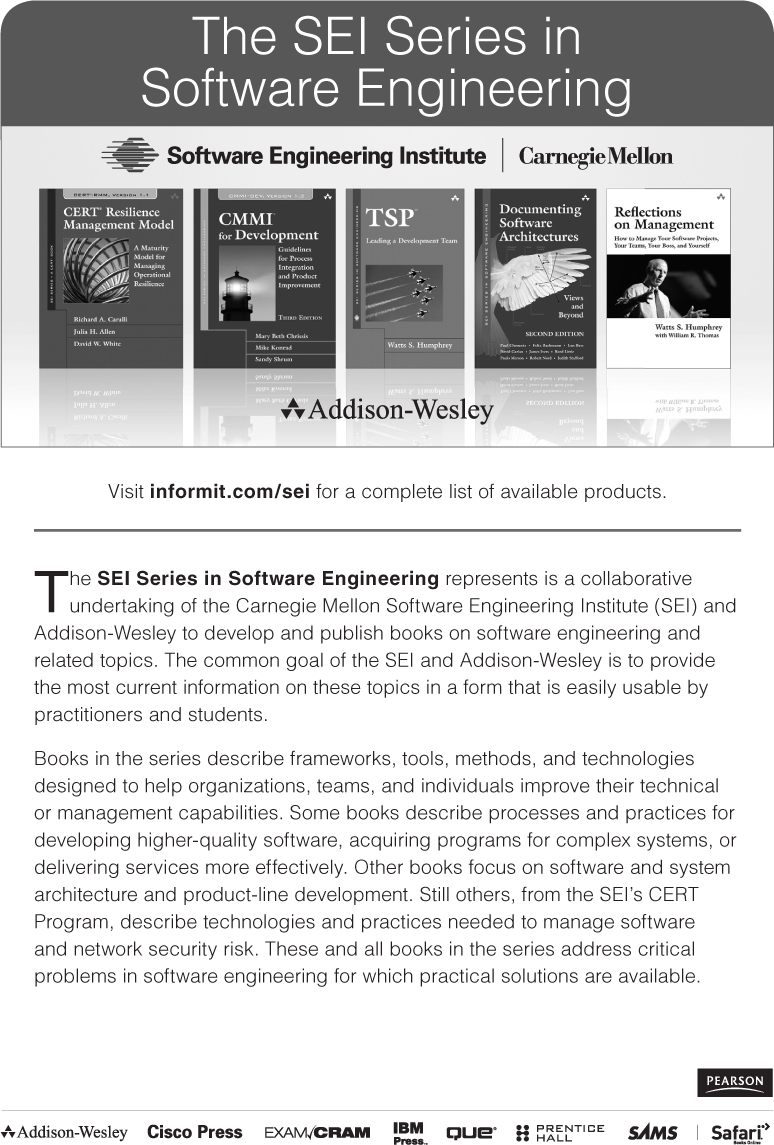Software Architecture in Practice
Third Edition
Len Bass
Paul Clements
Rick Kazman

Upper Saddle River, NJ Boston Indianapolis San Francisco
New York Toronto Montreal London Munich Paris Madrid
Capetown Sydney Tokyo Singapore Mexico City
 Software Engineering Institute | CarnegieMellon
Software Engineering Institute | CarnegieMellon
The SEI Series in Software Engineering
Many of the designations used by manufacturers and sellers to distinguish their products are claimed as trademarks. Where those designations appear in this book, and the publisher was aware of a trademark claim, the designations have been printed with initial capital letters or in all capitals.
CMM, CMMI, Capability Maturity Model, Capability Maturity Modeling, Carnegie Mellon, CERT, and CERT Coordination Center are registered in the U.S. Patent and Trademark Office by Carnegie Mellon University.
ATAM; Architecture Tradeoff Analysis Method; CMM Integration; COTS Usage-Risk Evaluation; CURE; EPIC; Evolutionary Process for Integrating COTS Based Systems; Framework for Software Product Line Practice; IDEAL; Interim Profile; OAR; OCTAVE; Operationally Critical Threat, Asset, and Vulnerability Evaluation; Options Analysis for Reengineering; Personal Software Process; PLTP; Product Line Technical Probe; PSP; SCAMPI; SCAMPI Lead Appraiser; SCAMPI Lead Assessor; SCE; SEI; SEPG; Team Software Process; and TSP are service marks of Carnegie Mellon University.
Special permission to reproduce portions of works copyright by Carnegie Mellon University, as listed on page , is granted by the Software Engineering Institute.
Many of the designations used by manufacturers and sellers to distinguish their products are claimed as trademarks. Where those designations appear in this book, and the publisher was aware of a trademark claim, the designations have been printed with initial capital letters or in all capitals.
The authors and publisher have taken care in the preparation of this book, but make no expressed or implied warranty of any kind and assume no responsibility for errors or omissions. No liability is assumed for incidental or consequential damages in connection with or arising out of the use of the information or programs contained herein.
For information about buying this title in bulk quantities, or for special sales opportunities (which may include electronic versions; custom cover designs; and content particular to your business, training goals, marketing focus, or branding interests), please contact our corporate sales department at or (800) 382-3419.
For government sales inquiries, please contact .
For questions about sales outside the U.S., please contact .
Visit us on the Web: informit.com/aw
Library of Congress Cataloging-in-Publication Data
Bass, Len.
Software architecture in practice / Len Bass, Paul Clements, Rick Kazman.3rd ed.
p. cm.(SEI series in software engineering)
Includes bibliographical references and index.
ISBN 978-0-321-81573-6 (hardcover : alk. paper) 1. Software architecture. 2. System
design. I. Clements, Paul, 1955 II. Kazman, Rick. III. Title.
QA76.754.B37 2012
005.1dc23
2012023744
Copyright 2013 Pearson Education, Inc.
All rights reserved. Printed in the United States of America. This publication is protected by copyright, and permission must be obtained from the publisher prior to any prohibited reproduction, storage in a retrieval system, or transmission in any form or by any means, electronic, mechanical, photocopying, recording, or likewise. To obtain permission to use material from this work, please submit a written request to Pearson Education, Inc., Permissions Department, 200 Old Tappan Road, Old Tappan, New Jersey 07657, or you may fax your request to (201) 236-3290.
ISBN-13: 978-0-321-81573-6
ISBN-10: 0-321-81573-4
Text printed in the United States on recycled paper at Courier in Westford, Massachusetts.
Fifth printing, September 2015
Preface
I should have no objection to go over the same life from its beginning to the end: requesting only the advantage authors have, of correcting in a [third] edition the faults of the first [two].
Benjamin Franklin
It has been a decade since the publication of the second edition of this book. During that time, the field of software architecture has broadened its focus from being primarily internally orientedHow does one design, evaluate, and document software?to including external impacts as wella deeper understanding of the influences on architectures and a deeper understanding of the impact architectures have on the life cycle, organizations, and management.
The past ten years have also seen dramatic changes in the types of systems being constructed. Large data, social media, and the cloud are all areas that, at most, were embryonic ten years ago and now are not only mature but extremely influential.
We listened to some of the criticisms of the previous editions and have included much more material on patterns, reorganized the material on quality attributes, and made interoperability a quality attribute worthy of its own chapter. We also provide guidance about how you can generate scenarios and tactics for your own favorite quality attributes.
To accommodate this plethora of new material, we had to make difficult choices. In particular, this edition of the book does not include extended case studies as the prior editions did. This decision also reflects the maturing of the field, in the sense that case studies about the choices made in software architectures are more prevalent than they were ten years ago, and they are less necessary to convince readers of the importance of software architecture. The case studies from the first two editions are available, however, on the books website, at www.informit.com/title/9780321815736. In addition, on the same website, we have slides that will assist instructors in presenting this material.
We have thoroughly reworked many of the topics covered in this edition. In particular, we realize that the methods we presentfor architecture design, analysis, and documentationare one version of how to achieve a particular goal, but there are others. This led us to separate the methods that we present in detail from their underlying theory. We now present the theory first with specific methods given as illustrations of possible realizations of the theories. The new topics in this edition include architecture-centric project management; architecture competence; requirements modeling and analysis; Agile methods; implementation and testing; the cloud; and the edge.
As with the prior editions, we firmly believe that the topics are best discussed in either reading groups or in classroom settings, and to that end we have included a collection of discussion questions at the end of each chapter. Most of these questions are open-ended, with no absolute right or wrong answers, so you, as a reader, should emphasize how you justify your answer rather than just answer the question itself.
Readers Guide
We have structured this book into five distinct portions. introduces architecture and the various contextual lenses through which it could be viewed. These are the following:
Technical. What technical role does the software architecture play in the system or systems of which its a part?


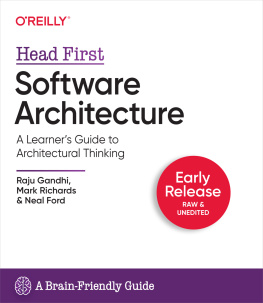

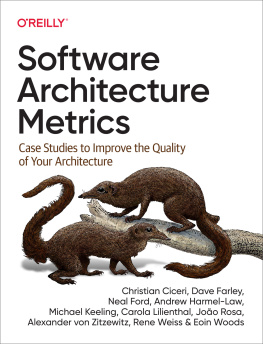
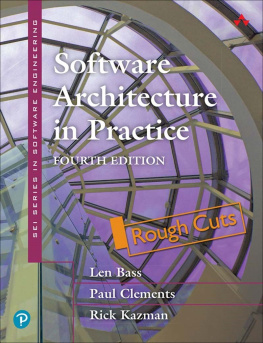
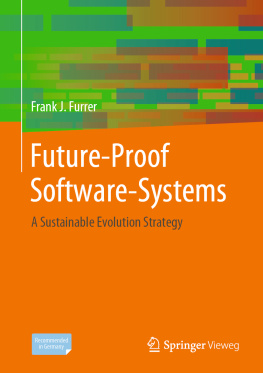
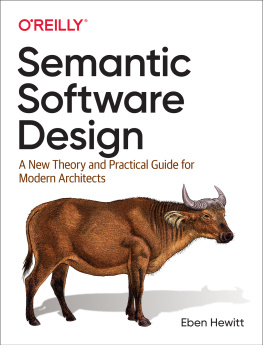

 Software Engineering Institute | CarnegieMellon
Software Engineering Institute | CarnegieMellon